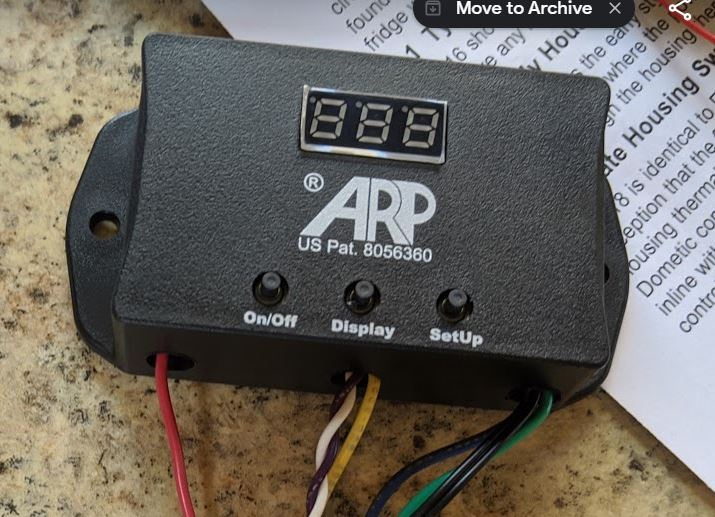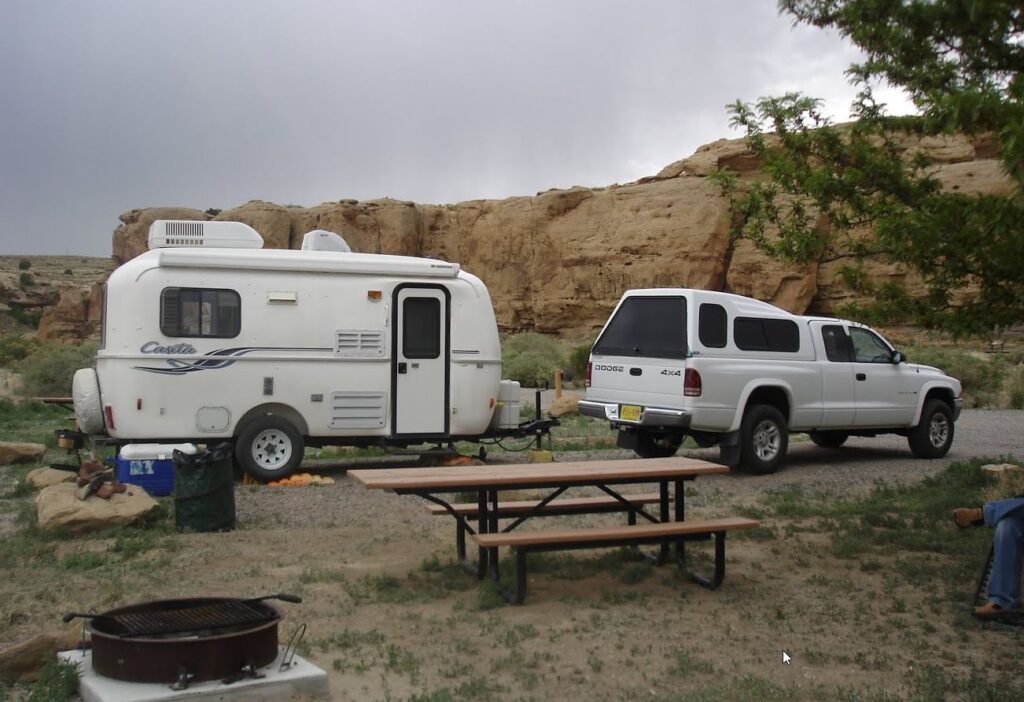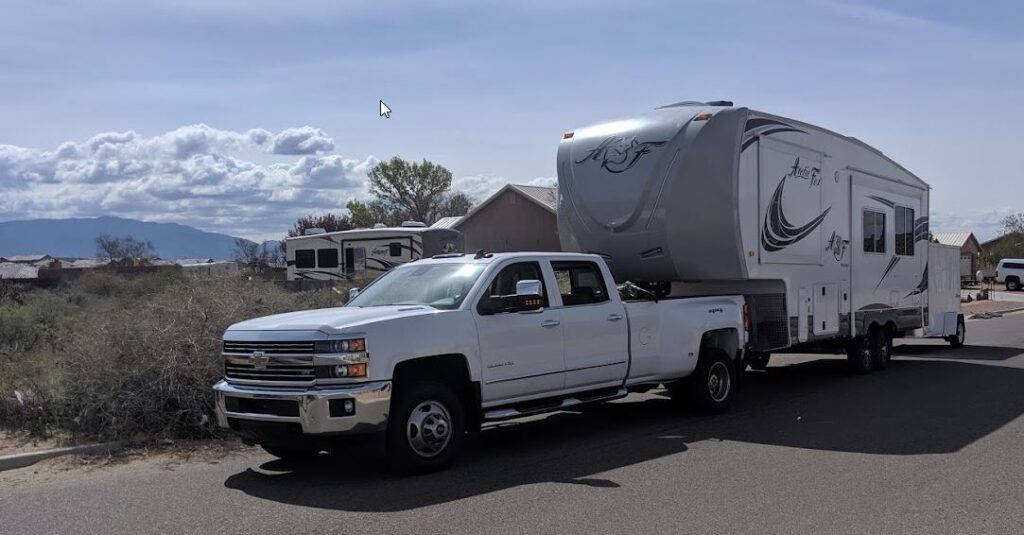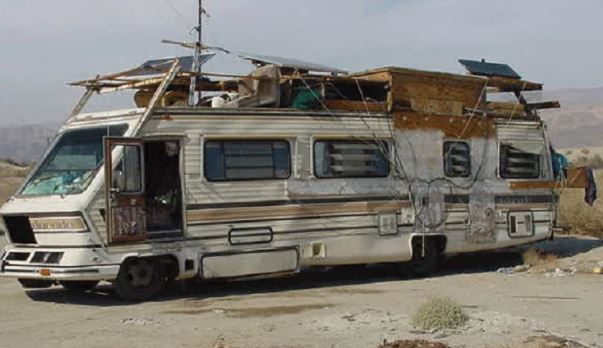When looking at all the systems and functions in a typical camper, I’d argue that the electrical system is the most important system once you reach your camping spot. The vast majority of features in your camper are dependent on electricity. I’m going to de-mystify the electrical systems for beginners and you will walk away with a basic understanding of how to best use electricity in your RV.
Overview
Your campers electrical system is really 2 systems in one. You have the 120V system which operates much like your sticks and brick home. You also have the 12V system which operates much like the system in your car.
The 120V system is used to run high power draw applications as well as to recharge the batteries in the 12V system.
The 12V system is used to run all your day to day lower power applications and contains batteries to allow it to operate when 120V is not available.
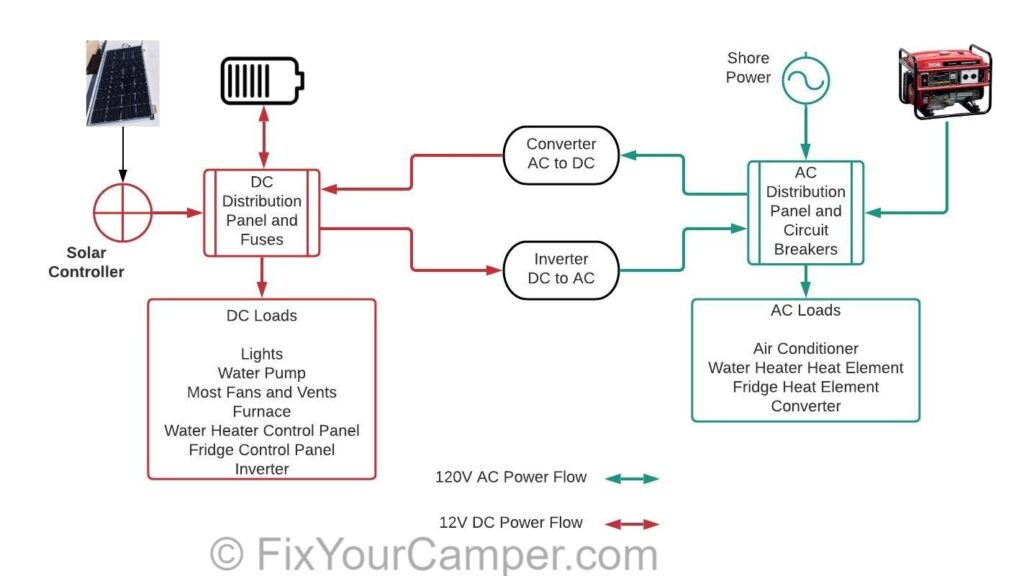
The two systems are tied together by the converter. The converter can take the 120V AC power and convert it to 12V DC power to run your 12V devices as well as to charge the batteries. An optional Inverter can work the other way and take the 12V DC power and make it into 120V AC power to run things that you typically need to plug into the standard household outlets.
Motorhomes generally have a 3rd power system to run the “coach”. Meaning for the engine and driving components. This system is often connected to the “house” or camper side so that the “house” batteries can charge while you’re driving down the road. Other than that, it is the same as an automotive system and won’t be covered in this article.
120V AC System
The 120V system gets it’s power for one of 3 sources.
- Shore Power Cord
- Generator
- Inverter.
Shore Power
Shore power come in via a cord that is connected to the power grid. Typically an RV has either a 30A or 50A connection based on it’s potential power needs.


A 30A service delivers a total of 30A at 120V AC. A 50A service is actually two 50A circuits being brought into the camper to deliver a total of 100A of usable power. and is usually found on larger units that have multiple air conditioners.
In addition to charging the 12V batteries via the converter, the AC system is also used to run high power demanding applications like Air Conditioners and Microwaves.
Use adapters to connect one type of connection to a different type of power source. You can plug a 30A camper into a 50A service or vice versa. You can also plug either into a standard home outlet which is either 15A or 20A.
WARNING
Be VERY careful typical 30A or 50A service outlet in a home like the one meant for your clothes dryer. All RV connections are 120V and that clothes dryer outlet is 240V. Many of these have no ground, introducing safety hazards in RV use.
You could cause extensive damage.
Remember, if you plug a larger camper rating into a lower rated outlet, you are limited on how many and what type of services you can use in the camper. For example, a 15A service will not be likely to be able to run:
- Air Conditioning
- Two high draw appliances simultaneously
- Coffee Pot
- Microwave
- Hair Dryer
- Portable electric heater
- Or even one high draw appliance while your batteries are being charged by the converter.
Likewise, as 30A service will not likely be able to power 2 air conditioners at the same time.
I always carry adapters to allow me to hook up to whatever power source may be available. Our current camper is setup for 50A service so my kit is:
50A Adapters
30A Adapters
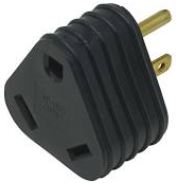
I do NOT recommend the cheap adapters such as this. I have personally had one overheat and know of several other people this has happened to. AVOID!!!
Get a quality dogbone style like the one above.
If you have to use an extension cord to reach that outlet in the garage for your camper, use a heavy duty one. Extension cords are rated by the gauge of the wire which corresponds to the thickness of the copper wires inside. This is usually represented by the following
<Gauge>/<Conductors> where a lower gauge is larger wire.
So a 12/3 cord would have 12 gauge wire and 3 individual conductors.
Due to the potentially high power draw I recommend at least 10/3 cord and as short as possible to reach the outlet.
Generator
Your camper may have a built in generator, which are typically made by Onan, or you may use a portable generator. A generator is optional, but sure can come in handy when you are camping somewhere that doesn’t have power hookups. You can use it to recharge your batteries via the converter, or to run high draw appliances.
I rarely use my portable generator, especially since I added some solar power. But I do mostly boondock and it is sometimes needed if we have several days of cloudy weather or I’m parked under trees.
I strongly recommend inverter type generators. They tend to be more fuel efficient, but much more importantly they run MUCH quieter than an open frame contractor generator. The Honda EU series inverter generators are the gold standard and is what I have now, although I’m seriously considering a switch. (UPDATE: I changed my Honda over to be capable of Duel-Fuel and now use Propane from the camper BBQ connection to run it.)
Using a portable generator is effectively the same as the Shore Power discussion above, including managing what can be run based on the size of the generator.
With a built in generator there has to be a way to disconnect the shore power when the generator is running. On some campers there is a plug near the generator that you plug your shore power cord into. Others have an automatic generator transfer switch that changes your power input from shore to generator when the generator is turned on. This makes sure you can’t accidentally hook up shore power and generator power at the same time.
Inverter
An Inverter takes the 12V DC power in the batteries of your camper and converts it into 120V AC power to run household types of items like phone chargers or even hair driers. Some campers have them built in, or they can be added. One critical function to have is if the Inverter is turned on, it should not feed AC power to the Converter. If you look at my diagram above and think about it, that would cause a loop of power and just sit there running down your batteries quickly.
Personally I just have a little no-name 150W portable inverter that I use to run our TV when we are boondocking.
Other folks have larger 1500-2000W units and can run their microwave or a hair dryer for brief periods of time. It’s important to keep in mind this will draw considerable power from your batteries and shorten how long you can go between re-charging.
12V DC
The 12V Dc system is really the heart of the RV electrical system. 12V is really the system that makes it practical to use the camper when off the grid. The 12V system runs the majority of the systems in the camper and gets supplemented by propane for higher draw functions like refrigeration, hot water, cooking and the furnace. When plugged in, a device called a Converter takes the shore power 120V and turns it to 12V to charge your batteries and run your 12V systems.
Batteries store the energy and allow you to use these systems when you are not hooked up to shore power. This article talks more about batteries.
Systems like the fridge or hot water heater usually can get their high power usage from either propane or 120V electricity, but they both use 12V for the control circuits. This makes since as 12V is always available whereas 120V is not.
There is a trend in the industry to switch from absorption fridges to electric only compressor models. These come in 12V (Dan Foss) or 120V (Residential) models and sometimes sold as an upgrade. These are fine if you usually camp where there is hookup power available, but if you boondock it will draw a lot of power from your batteries and this should be taken into consideration.
Boondocking
One of the biggest questions I get asked is “How long can I boondock?” As with most things, the answer is “It depends.” To get a good guestimate on this you need to look at how you camp and how much power you will be using. We are looking to get a rough guess on how many Amp Hours we are going to be using. An Amp hour is the number of Amp’s consumed in an hour. So if you run a light that draws 1A of power for 1 hour you consume 1AH of power from your batteries. Here are some rough numbers on power usage, it varies by device and should be confirmed, but this will get you started.
- 0.1A LED Light
- 1.0A Incandescent Light
- 7.0A Furnace Fan
- 1-2A Phantom loads like circuit boards and smoke/propane detectors (24×7 – this one doesn’t go away)
- 4-8A Water Pump
The RV dealers typically only provide a single “Marine” type battery with the campers. These batteries hold between 60AH to 80AH. BUT, with a lead acid battery it is best to not draw it down more the 1/2 of it’s total capacity. You can draw more than that from it, but it damages it and starts shortening the life of the battery. That means you have 30-40AH of usable capacity.
With this setup you can go out for a night or 2 and if you don’t need to use the furnace you’ll probably be fine. For more than that you’ll need to add battery capacity or provide a way to re-charge like via a generator or solar.
Click here to learn more about Boondocking and click here for more info on batteries.
Storage
Your camper will have multiple “phantom” power draws. Things like control boards, smoke detectors, etc that will pull power all time. This means that if you do nothing and leave it sitting for an extended period of time, the batteries will draw down. On most factory setups your batteries will be completely drained after 1-2 weeks! YIKES.
My preferred way to deal with this is to leave the unit plugged into shore power. If your camper is around 10 years or less old, it almost certainly has a modern 3 or 4 phase converter. This is a good thing and means that while plugged in the Converter can take good care of your batteries. Some older units have a 1 or 2 phase converter and they will over charge the batteries – ruining them if left plugged in for long periods of time.
My first camper had this problem. That is why on it, and every trailer I’ve had since, I’ve installed a Progressive Dynamics converter to take care of the batteries. These guys work – I’ve had batteries last in excess of 6yrs being maintained by these units.
The alternative to leaving it plugged in is to disconnect the batteries from the trailer. Some trailers will have a Battery Disconnect Switch that makes this simple. If yours doesn’t have a switch, you can simple disconnect the wires from one side of the battery. I recommend disconnecting the negative side….all things being equal. Also, when doing this make sure you charge the battery completely before storage. This will extend the life of the batteries as well as prevent the battery from freezing in extreme cold.
But even disconnected, Lead Acid batteries will slowly drain themselves over several months. If you can’t stay plugged in and need to store the rig for a long time, consider taking the batteries into the garage and hooking them up to something like a Battery Tender.
Summary
So we learned that our campers have a Home 120V AC, a House 12V DC and maybe even a Car 12V DC system. These interdependent systems work together to give us all the features of home while out on the road.
The best place to go and discuss and learn more about these system is the Fix Your Camper Member Community. That is where we are gathering the most experienced camper community on the internet with the goal of helping each other get more out of our campers.

